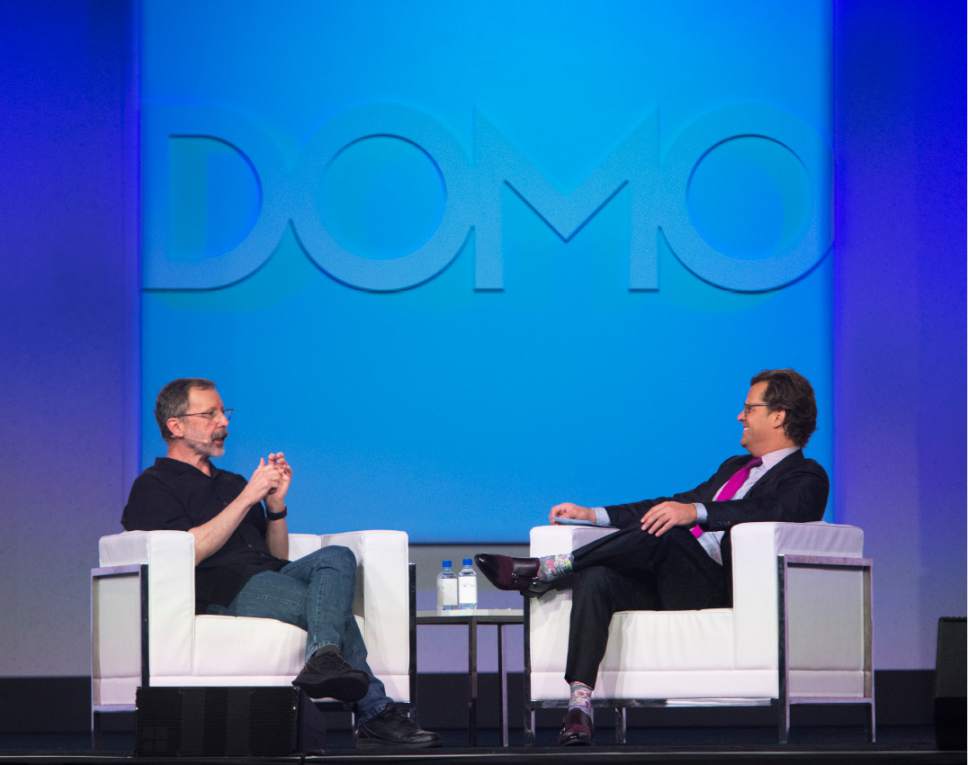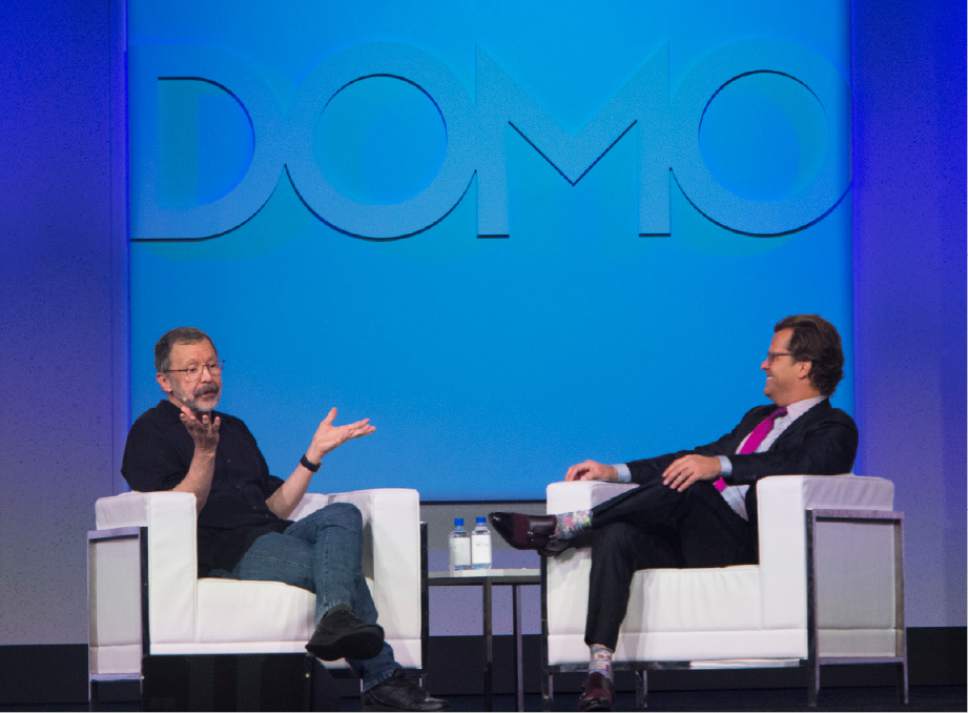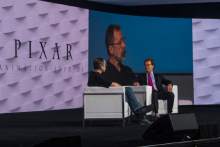This is an archived article that was published on sltrib.com in 2017, and information in the article may be outdated. It is provided only for personal research purposes and may not be reprinted.
At 72, Ed Catmull has no plans to retire from his tower atop the world of computer-animated movies.
While leading Pixar Animation Studios, which he co-founded with the late Apple leader Steve Jobs and others, Catmull has won five awards from the Academy of Motion Picture Arts and Sciences, including a 2001 Oscar.
He also led Pixar through a string of huge successes after its release of the first full-length computer-animated motion picture, "Toy Story." Those include "Cars," "Wall-E," "Finding Nemo," "Brave," "Up," "A Bug's Life," "Inside Out," "Ratatouille," "Monsters Inc.," "The Incredibles" and a bunch of sequels.
That success came after Catmull grew up in the Salt Lake Valley and earned a doctorate at the University of Utah. His degree focused on computer-generated graphics, which led down a rock-strewn path 21 years later, to "Toy Story."
"As much as anyone on the face of the earth, Ed has pushed computer-generated visuals into people's lives," said Richard B. Brown, dean of the U.'s College of Engineering.
But what Catmull talks about these days is not so much the animation technology he helped develop, nor all the movies. Rather, it's the business of managing creativity, or, as he would put it, removing barriers so employees' creativity can shine through a sometimes stifling hierarchy.
Much of his approach to fostering creativity came, he says, from his experiences at the U. at a time he describes as an almost magical confluence of people, government funding and the moment.
—
Breakthroughs • Ed Catmull was born in 1945 in West Virginia, where his mother was staying while his father was a Marine in the Pacific during World War II. But with the war soon over and his father, Earl Catmull, mustered out of the service, the couple — members of The Church of Jesus Christ of Latter-day Saints — moved to Utah.
The eldest of five children, Ed Catmull grew up in houses his father built when not teaching math or being a principal at area high schools.
Catmull developed a fascination with animation through comic books and television, especially the florid introductions to Sunday broadcasts of "The Wonderful World of Disney" on the family's 12-inch, black-and-white TV.
In a 2014 book, "Creativity Inc.," Catmull wrote that he had two heroes when he was growing up — Walt Disney and Albert Einstein — the latter who "dared to bend the implications of what we thought we knew."
After graduating from Granite High School in 1963, Catmull went to the U., planning to pursue his passion for animation. But he ended up with bachelor's degrees in physics and the brand-new discipline of computer science.
Catmull then worked briefly for Boeing before returning to Utah, he told The Salt Lake Tribune recently, "to address certain issues." He opposed the war in Vietnam, applied for conscientious-objector status and counseled others about the draft.
Catmull also entered the U.'s graduate school of computing, seeing it as the "frontier" of a new field.
Fellow students included Alan Kay, who developed "object-oriented programming," still widely used in computer programming; John Warnock, who co-founded Adobe; and Jim Clark, subsequent founder of Silicon Graphics and Netscape.
Funding much of the school's work was ARPA, the federal Advanced Research Projects Agency, which threw money with few strings attached at universities for research after the Soviet Union's 1957 launch of the Sputnik satellite.
Professors David Evans and Ivan Sutherland, pioneers in the development of computer graphics, assembled an eclectic group of U. graduate students who might not have been admitted elsewhere, Catmull said.
"I knew it was different at the time," he added. "It actually had a profound effect on me."
This was the era when the U. became the fourth node on the ARPANET, which later morphed into the internet.
Catmull said he gravitated to computer graphics because it allowed him to combine his infatuation with animation and computers.
A big challenge at the time was how to depict curved surfaces realistically. Catmull dove into the problem, producing a dissertation and a short film now legendary in computer graphics circles — a four-minute computer animation of his left hand. That four minutes, Catmull said, took him and fellow student Fred Parke 60,000 minutes to complete.
Believed to be one of, if not the first, animated short films created on a computer, it was added to the National Film Registry in 2011. That short, and another piece of a film Parke created, made a cameo appearance in the 1976 science fiction film "Futureworld."
—
Star power • Catmull earned his U. doctorate with a dissertation on digital representations of curved surfaces. He also left the U. with the goal of creating the first fully computer-animated feature-length movie.
His path took him first to the New York Institute of Technology, where he led a team that was to develop computer animation.
Then, in 1977, George Lucas' first "Star Wars" film opened. The blockbuster led Lucas to develop new special-effects tools. He formed a computer division within Lucasfilm and hired Catmull to run it.
By the mid-1980s, however, Lucasfilm was foundering financially and Catmull's former U. classmate Kay arranged a meeting for him with Steve Jobs, who had left Apple Computer Inc. after losing a power struggle. At the time, Kay was Apple's chief scientist.
"Ed combines top technical abilities with a calm, unflappable, no B.S. personality that inspires confidence," Kay wrote in an email, describing Catmull as "a natural 'quiet leader.' "
A few months after the 1985 meeting, Jobs bought what became Pixar Animation Studios. It was largely a hardware company, and, Catmull concedes, he was in over his head running it.
But, as he told U. students in a 2012 commencement speech, he read all kinds of business-management books to get up to speed and discovered something interesting: "The information in them was true, but it was strangely free of content."
Residing in Northern California, Catmull also observed the Silicon Valley boom as companies sprouted up to overnight success, able to employ the best talent, pursue the best ideas and attract high-profile customers.
"Then they'd go public and the CEO would get his picture on the cover of Fortune magazine and then the company would do something incredibly stupid," he said.
"Why is it that companies at the top of their game do stupid things?" Catmull wondered.
Even in his own company, things didn't always go well — despite "Toy Story's" phenomenal run after its 1995 release.
Catmull said he and other managers were shocked to find that they didn't see divisions within the company during the making of "Toy Story." Production managers felt marginalized and disrespected by the creative teams — and they were.
His dream of making the first feature-length animated movie realized, Catmull shifted his passion to understanding why companies made bad decisions after initial successes and trying to figure out how he could help nurture and sustain creativity at Pixar.
For him, it's less about bosses managing creativity than getting out of the way.
That involves removing hierarchy from meetings and communication.
"It isn't easy," Catmull said. "You have to pay continual attention to it."
In meetings, whoever leads a discussion needs to provide a safe environment for open conversation. That person, Catmull said, "can either convey control or they can convey safety. If they're conveying control, then we actually do talk about it afterward and we will make changes."
Josh James, one of Utah's most successful tech entrepreneurs, invited Catmull to give the keynote speech at a recent conference of his company Domo. The company's products bring together statistics and other information to give managers real-time views of things such as sales, cash flow and employee vacancies.
"Ed's story is clear," James said in an email. "While data and technology are important, success really comes down to the people in your organization. His story challenges you to think if you, as a leader, are creating the right environment to get the best out of all the people on your teams."
Catmull is revising his book for a new edition and remains "incredibly busy and highly engaged" in Pixar. But he also is giving thought to what happens when he leaves the company, the challenge of providing continuity on Pixar's intellectual and cultural aspects.
While no longer a practicing Mormon, Catmull said he is grateful for the atmosphere he grew up in during the 1950s in Salt Lake County.
"I tremendously value that culture," he said. "I never want to give any indication that I do not value what was there then or what is there now."







